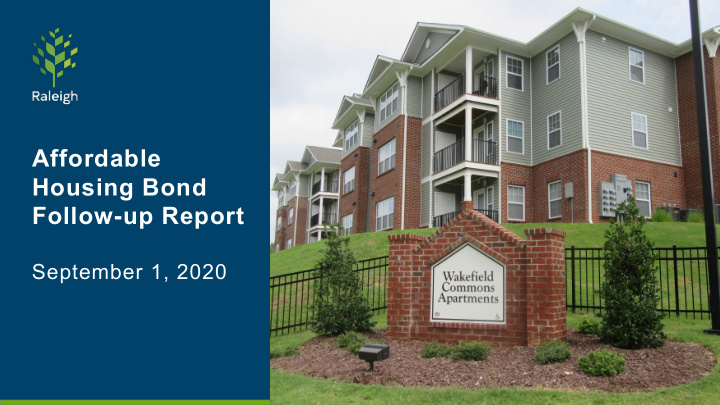



Affordable Housing Bond Follow-up Report September 1, 2020
Agenda • Recap of elements and policy objectives • Proposed combined funding matrix • Existing income targeting by program • Policy options for greater 30% AMI targeting
Elements and policy objectives
Recommended Bond Package Elements Bond Elements Percent Allocation Amount Transit-Oriented Site Acquisition 20% $16,000,000 Public-Private Partnerships 35% $28,000,000 LIHTC Gap Financing 30% $24,000,000 Owner-Occupied Home Rehabilitation 7.5% $6,000,000 Down Payment Assistance 7.5% $6,000,000 Total Bond Package – $80M Policy Focus: Equitable Development Around Transit
30% AMI Policy Objectives Two of the five bond elements or buckets • Public-private partnerships • LIHTC gap financing
Combined Funding Matrix
Combined Funding Matrix • Draft document based on conservative assumptions. • Displays the full spectrum of income groups served. • Per unit average subsidy in rental development gap financing based on increased 30% AMI targeting.
Current Income Targeting and Voucher Holders
Existing Income Targeting • Most recent 13 LIHTC projects placed in service. • Most recent 6 permanent supportive housing projects placed in service. • Raleigh Housing Authority public housing and Section 8 program.
Existing Tax Credit Developments In the 13 most recently funded properties: • 14% of the units were required to target 30%AMI • 37% of the units were occupied by 30% households • 40% of tenants were voucher holders • Average subsidy per unit was $19,623
Recent Permanent Supportive Housing Developments In the 6 most recently funded properties: • 3% of the units were required to target 30%AMI • 43% of the units were occupied by 30% households • 46% of tenants were voucher holders • Average subsidy per unit was $49,662
Raleigh Housing Authority Public Housing and Section 8 • 76.64% of public housing units occupied by 30% AMI or below. • 83.37% of voucher holders 30% AMI or below. • Approximately 300 vouchers annually become available. • Only about 30% of new eligible voucher holders actually locate an available unit.
Raleigh Housing Authority Public Housing and Section 8 • Public housing waiting list: 4,196 households • Section 8 waiting list: 6,572 households • 1,925 households on both waiting lists
30% AMI Policy Options Operating and Funding Consideration • A rental project where all units are targeting to 30% AMI cannot support any debt service; • Such a project does not generate sufficient rental income to cover operating expenses; and therefore: • 30% AMI units must be mixed with higher income targets for a project to be viable and sustainable. • The tax credit program is the most cost effective method for creating the highest number of units. • Non-profit partnerships can also target 30% AMI.
Public-Private Partnerships ($28 Million) Objective: EDAT. Increasing Supply of Affordable Housing • $10 Million for permanent supportive housing for very low income (30% AMI or lower) chronically homeless individuals (50 units). • $10 Million for non-profit partners to create or preserve small scale projects where not less than one-third of total units serve 30% AMI or lower. • $8 Million plus regulatory incentives for new rental development where not less than 20% of the units are affordable at 60% AMI for not less than 30 years (voluntary inclusionary model) or the development of “missing middle” affordable homeownership opportunities.
LIHTC Gap Financing - $24 Million Objective: EDAT. Increasing the supply of affordable housing serving 30% AMI • Require 25% of units in 9% tax credit projects to target 30% AMI. • Require 10% of units in 4% tax credit projects to target 30% AMI. • The City (or County) subsidy required to create a 30% AMI unit is more than double the amount needed to create a 60% AMI unit and thus fewer total units can be created with same amount of funding.
Discussion
Recommend
More recommend